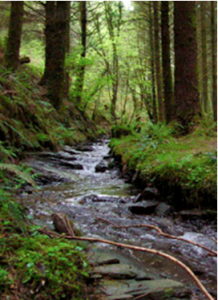Townline Creek Monitoring
Contents
By George Powell
 Through our partnership with Nottawasaga Valley Conservation Authority (NVCA) and the Grey Sauble Conservation Authority (GSCA), we continue our water quality monitoring program at four locations along Townline Creek and at one location on Silver Creek. The purpose of the monitoring is to understand the health of two streams in our area that are facing significant development pressures.
Through our partnership with Nottawasaga Valley Conservation Authority (NVCA) and the Grey Sauble Conservation Authority (GSCA), we continue our water quality monitoring program at four locations along Townline Creek and at one location on Silver Creek. The purpose of the monitoring is to understand the health of two streams in our area that are facing significant development pressures.
Background
Townline Creek is located along the northeast edge of the Grey Sauble Conservation Authority watershed area. It originates from springs above the Niagara Escarpment brow east of Blue Mountain Resorts (BMR) property picking up ski hill run-off as it flows down a steep forested valley before exiting near the resort’s South Base Lodge. It crosses under Gord Canning Drive, picks up run-off from urban development and a golf course in the area. It flows down a concession ditch on the eastside of Osler Bluff Road, then crosses Highway 26 and flows into the Provincially Significant Silver Creek Wetland Complex at the northwest edge of the NVCA watershed area, and into Georgian Bay. While this is a relatively small watershed and one that normally would not be monitored, it demonstrates the impacts of development pressures in the area. Water temperatures during summer months at the top of the Escarpment are about 10 degrees Celsius but can reach over 20 degrees Celsius in the lower reaches of the stream.
Silver Creek is the next creek east of Townline Creek. Like Townline, it is spring-fed. Development pressures are, however, significantly less, at present. As it flows down through the Niagara Escarpment to Georgian Bay it is for the most part well shaded and water temperatures are relatively cool, providing excellent fish and amphibian habit. Trout and salmon regularly spawn in Silver Creek . Development pressures at its headwaters and around the Provincially Significant Silver Creek Wetland Complex are a concern and could seriously impact the watershed.
The close proximity of Silver Creek to Townline Creek provides a benchmark for water quality comparison purposes. The former is an example of a high-quality, coldwater stream not yet impacted while the latter is a stream beginning to see impairment due to organic enrichment.
Poor results for Townline Creek
Results generated from our previous annual sampling identified that phosphorus and suspended solids were of concern to the health of Townline Creek and that monitoring should be continued to identify potential pollution sources and to track changes in stream condition over time. Benthic sampling and analysis have been added to Townline Creek analysis to further assess stream health.
Total Suspended Solids Concentrations (TSS) for Townline Creek at the station closest to the watercourse mouth were above those observed at all other Niagara Escarpment watercourses monitored in the Collingwood area. Only Townline Creek exceeded the TSS baseflow criterion suggested by Environment Canada. During storm events Townline Creek again had the highest TSS concentration yet in 2012 no station exceeded the suggested Environment Canada TSS criterion.
Benthic macroinvertebrates are the group of organism commonly used to also assess water quality in terms of a healthy biodiversity. Included are insect larvae, crustaceans, snails, clams, worms, leeches and flatworms, etc. These aquatic invertebrates are typically abundant in all types of aquatic ecosystems. They are also relatively sedentary and remain localized in their preferred habitat and can be easily displaced when they cannot tolerate their environment. Long term studies of individual species’ tolerances to environmental stressors have resulted in the development of multiple water quality assessment (such as the Family Biotic Index or “FBI”) that are typically designed to summarize benthic communities based on a single stressor, such as organic pollution. This index has been used since 2009 in our monitoring programs. We also are now using BioMAP (Biological Monitoring and Assessment Program), a newer index which attempts to provide a more holistic view of stream health based on the size of the watercourse.
Benthic samples are taken in the autumn from Townline Creek immediately upstream of the Hwy 26 and Osler Bluff Road intersection. All samples are identified to the lowest practical level (typically genus or species).
Recommendations for improving Townline Creek
- Establish partnerships with local land owners/managers to examine land management practices and determine if changes can be made to lessen impacts on Townline Creek.
- A site walk with BMWTF, GSCA or NVCA and Blue Mountain Resort staff to discuss practical solutions such as erosion prevention on ski slopes, improved storm water management of developed areas. i.e. parking areas.
- Contact the Monterra Golf Club to discuss buffer establishment opportunities to reduce the intensities of run-off.
- Approach The Blue Mountains and Grey County to discuss construction guidelines for sediment and nutrient control to ensure they are adequate for the works being conducted, that they are being properly utilized and that they are properly inspected and maintained.
There are serious development pressures facing the Silver Creek. Its huge watershed drains approximately 2700 Hectares (Ha).
At its headwaters, above the brow of the Escarpment, the approved development of Castle Glen on Grey Road 19 comprises some 620 hectares with 1929 units.
There is significant additional proposed development in the Craigleith area of the Town of the Blue Mountains. The total future units are estimated at 12,071. Developments Impacting the Silver Creek watershed are shown in Table 1.
| Name of Subdivision | Total Future Units |
| Castle Glen | 1929 |
| Meridian/Terrasan | 214 |
| Windfall | |
| Havens | 18 |
| Consulate-West | 28 |
| Consulate-East | 430 |
| Huntingwood Trails | 437 |
| Tanglewood | 631 |
| TOTAL | 4296 |
| – Potential Units to be developed that drain into the Silver Creek Watershed |
|
Without improved watershed management in the Silver Creek Watershed, the health of this high-quality stream and its provincial significant wetland will be impacted resulting in serious wetland degradation and increased nutrient loading to Nottawasaga Bay. .
Improved riparian buffers, re-vegetation along the stream reaches, ensuring that construction best practices are used to prevent siltation and stormwater management improvements are needed to truly protect the watershed. These are the challenges we face and only through unrelenting insistence to these recommendations can we hope to win the day for the environment.


